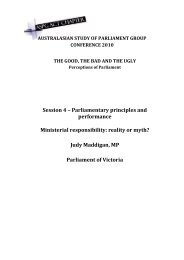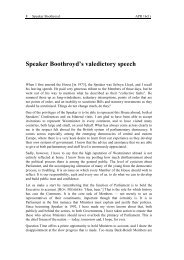Comic Commentators: Contemporary Political Cartooning in Australia
Comic Commentators: Contemporary Political Cartooning in Australia
Comic Commentators: Contemporary Political Cartooning in Australia
- No tags were found...
Create successful ePaper yourself
Turn your PDF publications into a flip-book with our unique Google optimized e-Paper software.
230 Book pages APR 24(2)organizations such as UNICEF today. 7 In chapter 8, ‘Cartoons for the Cause…’,Marian Sawer, rem<strong>in</strong>ds us that, appreciat<strong>in</strong>g the value of humour to assist convey amessage effectively, <strong>Australia</strong>n Government Departments, led by Peter Wilenski,uniquely and <strong>in</strong>novatively commissioned cartoonists to assist with the equityagendas <strong>in</strong> the 1980s. She also rem<strong>in</strong>ds us of the impact of what we may call thecaptive cartoonists at the other end of the twentieth century <strong>in</strong> her reflections oncartoon<strong>in</strong>g and the Suffragettes. Sawer recalls that the thrust of ma<strong>in</strong>stream presscartoon<strong>in</strong>g <strong>in</strong> those times was designed to keep women <strong>in</strong> their place, just as thosecommissioned <strong>in</strong> counterpo<strong>in</strong>t to present the positives of womens’ <strong>in</strong>volvementencouraged the protestors by the ridicule they heaped on those males fearful thesocial skies would fall <strong>in</strong> if women were given the vote. Cartoons were <strong>in</strong> the onecase deployed to re<strong>in</strong>force and support the establishment and <strong>in</strong> the other to besubversive of it — because that is what they were paid to do.The editorial cartoon, by contrast, although <strong>in</strong>evitably reflect<strong>in</strong>g the major politicalissue of the day, is generated by the cartoonist as <strong>in</strong>dependent commentary and isgenerally free from editorial direction or <strong>in</strong>terference. Mart<strong>in</strong> Rowson tells us that<strong>in</strong> the <strong>in</strong>terwar years and after, ‘Vicky and Low had their dissidence formalized <strong>in</strong>their contracts with Beaverbrook on The Even<strong>in</strong>g Standard, by which they weregiven almost total licence to peddle po<strong>in</strong>ts of view entirely at odds with those notjust of the paper’s editorial l<strong>in</strong>e but also of the readers’. He suggests this is becauseunlike most (editors), Beaverbrook understood the role of the (political) cartoonist.In <strong>Australia</strong>, Joan Kerr has argued that the emergence of the editorial cartoonist is amore recent development. 8 She tells us that <strong>Australia</strong>’s cartoon <strong>in</strong>dustry developed<strong>in</strong> a very different context from the one <strong>in</strong> which it now operates. There were thedays of ‘uncritical acquiescence to editorial demand’ as the norm (p. 36).Cartoonists, or perhaps more accurately comic illustrators as she describes them,drew to amuse, reflect<strong>in</strong>g different aspects of society, be this <strong>in</strong> publications likePunch <strong>in</strong> its various <strong>Australia</strong>n forms, or <strong>in</strong> The Bullet<strong>in</strong>, which did so much toencourage and support this emerg<strong>in</strong>g <strong>in</strong>dustry. In contrast to the bit<strong>in</strong>g specifics oftoday’s editorial cartoonists, who see their mission to challenge the exist<strong>in</strong>gestablishment regardless of who currently makes it up, she argues that cartoonsonce necessarily had more of a timeless quality, mirror<strong>in</strong>g back synoptically andgenerally society as it was then — or reflect<strong>in</strong>g the dom<strong>in</strong>ant culture.Like artists <strong>in</strong> earlier times whose liv<strong>in</strong>g depended entirely on the patronage of thechurch or of an aristocratic family, cartoons were commissioned to reflect theirproprietors’ <strong>in</strong>terests and this, necessarily, is what they did. When this changed,Joan Kerr po<strong>in</strong>ts out that it was the often the self-imposed political correctness of7 In an article on ‘<strong>Cartoon<strong>in</strong>g</strong> and democratization world-wide’, John A Lent reports thatUNICEF has been us<strong>in</strong>g animation for more than a decade to br<strong>in</strong>g public awareness toproblems such as the plight of the girl child, and Canada’s National Film Board made anaids cartoon film to assist with its campaigns <strong>in</strong> its aid programs.8 In a volume written to accompany an ‘Artists <strong>in</strong> Black and White…
















